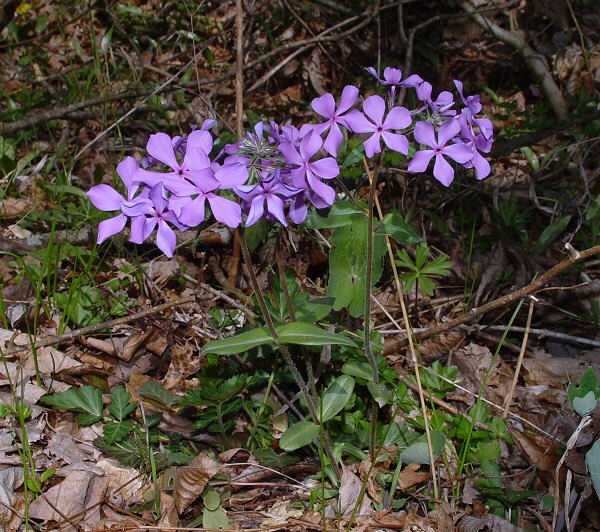Phlox divaricata L.
Blue Phlox

Native
CC = 4
CW = 3
MOC = 90
© DETenaglia
Phlox divaricata L.Blue Phlox | |
 |
Native CC = 4 CW = 3 MOC = 90 |
© DETenaglia |
|
Family - Polemoniaceae Habit - Perennial forb with slender rhizomes. Both vegetative and fertile stems usually present. Stems - Vegetative stems 1 to several, morphologically distinct from the flowering ones, usually overwintering (the leaves at least partly evergreen), 2-18 cm long, decumbent, rooting at the lower nodes, densely pubescent with short, appressed to curved hairs. Flowering stems ascending to erect, to 45 cm, typically 1-8, with 4-6 nodes, moderately to densely pubescent with curved or crinkled hairs, these often gland-tipped toward the stem tip.
Leaves - Opposite, simple, entire, sessile. Leaves of the vegetative stems elliptic, angled to a bluntly or sharply pointed tip, angled at the base, the largest 1.5-5.0 cm long and 10-20 mm wide, the margins usually hairy, the surfaces moderately hairy to nearly glabrous; those of the flowering stems with the blade oblanceolate to elliptic or ovate toward the stem base and mostly angled or tapered at the base, grading to lanceolate toward the stem tip and broadly angled to rounded or truncate at the base, variously rounded to bluntly pointed at the tip, the largest 2.5-5.0 cm long, at least the uppermost hairy along the margins, the surfaces sparsely to densely pubescent with curved or crinkled hairs, sometimes nearly glabrous with age, the hairs often gland-tipped on the uppermost leaves, the secondary veins obscure, pinnate and not forming conspicuous loops.
Inflorescence - Aggregate of 8-25 flowers appearing as a small, domed panicle. Flower stalks 4-13 mm.
Flowers - Calyces 6-10 mm long, the lobes slender, each tapered evenly to a short sharp extension of the midnerve, glandular-hairy. Corollas lavender to light purple or pale blue, rarely white, the tube 11-17 mm long, glabrous externally, with a slight constriction 1.5-3.0 mm above the base, the 5 lobes 10-15 mm long and 5-9 mm wide, obovate, rounded at the tips, sometimes with an abrupt, minute point at the very tip. Stamens with the filaments 5-14 mm long, the anthers positioned above the stigma within the tube. Style 0.5-1.5 mm long, the stigmas 1.0-1.5 mm long.
Fruits - Capsules with 3 seeds, these 2-4 mm long, oblong-ovate to occasionally broadly ellipsoid, slightly flattened, the surface yellowish brown to dark brown, faintly to moderately wrinkled, not becoming sticky when moistened.
Flowering - April - June. Habitat - Forests, streambanks, bases of bluffs, roadsides. Origin - Native to the U.S. Lookalikes - Other species of Phlox. Other info. - This is the most common species of Phlox in Missouri, occurring across the state wherever appropriate habitat is present, and also common across the eastern half of the continental U.S. It blooms early, lending one of the first splashes of color to the springtime woodland. It is easily recognized as a species of Phlox by its opposite, sessile leaves and purple flowers with spatulate petals; however, several other species of Phlox have a similar appearance and can easily be confused. Traits which point to this species are hairless corolla tubes, functional parts (stamen and style) which are usually not visible without dissecting the flower, and the presence of vegetative offsets near the main flowering stems. The flowers are usually blue-purple, but pink or white forms are occasionally encountered (see photo above). Photographs taken off Northwood Rd., Platte County, MO., 4-7-00, and near Van Buren, MO., 4-15-01 (DETenaglia); also at Young Conservation Area, Jefferson County, MO, 4-25-2013, 4-12-2017, and 5-4-2018, Greensfelder County Park, St. Louis County, MO, 4-20-2010, and at Valley View Glade Natural Area, Jefferson County, MO, 5-24-2021 (SRTurner). |